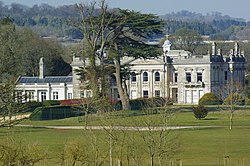Tedworth House
| Tedworth House | |
|---|---|
 | |
| Location | Tidworth, Wiltshire, England |
| Coordinates | 51°13′36″N 1°40′05″W / 51.2267°N 1.6681°W |
| Built | 1830 |
Listed Building – Grade II* | |
| Designated | 24 October 1984 |
| Reference no. | 1339397 |
Tedworth House, also known as South Tidworth House,[1] is a 19th-century country house in Tidworth, Wiltshire, England. It is a Grade II* listed building.[1]
The house and its grounds were in Hampshire until 1991, when the county boundary was redrawn.[2]
History
The first house on the site, on the southwest outskirts of South Tidworth, was well established when it was purchased by Thomas Smith in 1650.[3] The estate passed to his grandson, John Smith (1656–1723), who became Chancellor of the Exchequer, and then to his son Thomas who died unmarried soon after in 1728.[4] It was inherited (together with the Vaynol Park estate in Wales) by Thomas Assheton (d.1774) of Ashley Hall, Cheshire, nephew of Captain William Smith, another of John Smith's sons.[5]
Assheton added Smith to his name, and his son Thomas Assheton Smith (1752–1828) was MP for Caernarvonshire and later for Andover.[6] After his death his son, also Thomas (1776–1858), a keen foxhunter who at one time kept 200 hounds, moved here with his horses and hounds.[7] He had the house rebuilt in ornate classical style in 1828–1830.[8][3][a] The new two-storey house, faced in ashlar, has an imposing south front where the three-bay centre has a pediment above four Ionic columns.[1]
It passed to Francis Sloane Stanley, nephew of his widow, who leased it first to Lord Broughton, a cabinet minister, and then from 1871 to Edward Studd, a wealthy indigo planter and racehorse owner, who was the father of the notable cricketer brothers.[9][3] Studd created a cricket ground and racecourse, then from 1874 until his death in 1876 made the house an evangelical centre.[9][10]
The estate was acquired in 1877 by Sir John Kelk, 1st Baronet, a civil engineering contractor, who carried out extensive restructuring in 1878–80.[9] It was inherited by Sir John William Kelk, 2nd Baronet in 1886.[3]
20th century
The War Office bought the estate in 1897, and in 1905 the house became the official residence of the General in Command of the Salisbury Plain Military District.[11][12] In 1911 the house stood in 500 acres (200 ha) of grounds, described as a "well wooded park".[12] In the First World War it became the Garrison Officers' Mess for Tidworth Camp,[3] which had been built in the north of the estate, and then accommodation for nurses.[11]
An annual Tidworth Tattoo was held on the polo ground in front of the house from the 1920s until 1972.[3]
During the Second World War the house served as a club for American soldiers, before reverting to its role as nurses' accommodation, then from 1977 was again the Officers' Mess.[11]
In 2011,[3] the house become a recovery centre for service personnel operated by the Help for Heroes charity,[13] which was officially opened in May 2013 by Prince Harry and Prince William.[14] Alterations had included the building of a three-storey accommodation block.[15] In 2021, the recovery centre was said to be run by the Ministry of Defence.[16]
Associated buildings
The two-storey stable block west of the house was built in the mid-19th century and forms three sides of a square, with an entrance archway in the east side. It is in red brick and has a 20th-century clock tower.[17]
A single-storey lodge, plain in style but with verandahs, was built at the north entrance to the estate in the early 19th century.[18]
Footnotes
- ^ Historic England give c.1860 for the rebuilding but this conflicts with other sources.
References
- ^ a b c Historic England. "South Tidworth House (1339397)". National Heritage List for England. Retrieved 18 February 2018.
- ^ "The Dorset, Hampshire, West Sussex and Wiltshire (County Boundaries) Order 1991". legislation.gov.uk. Retrieved 28 May 2020.
- ^ a b c d e f g "Tedworth House". Drumbeat. Archived from the original on 18 February 2018.
- ^ "SMITH, Thomas I (1686-1728), of South Tidworth, Hants". History of Parliament Online. Retrieved 1 June 2020.
- ^ Eardley-Wilmot 1893, p. 3.
- ^ "ASSHETON SMITH, Thomas (c.1752-1828), of Faenol, Caern. and Tidworth, Hants". History of Parliament Online. Retrieved 31 May 2020.
- ^ Boase, George Clement. . Dictionary of National Biography. Vol. 53. pp. 134–135.
- ^ Eardley-Wilmot 1893, p. 60.
- ^ a b c "Question: Tedworth". Wiltshire Community History. Wiltshire Council. Retrieved 3 June 2020.
- ^ Grubb, Norman (2014) [1933]. "1". C. T. Studd: Cricketer & Pioneer. CLC Publications. ISBN 978-1-61958-197-5.
- ^ a b c "Last lunch at Tedworth House". Salisbury Journal. 3 February 2011. Retrieved 22 November 2014.
- ^ a b Page, William, ed. (1911). "Victoria County History: Hampshire: Vol 4 pp391-394 – Parishes: Tidworth, South". British History Online. University of London. Retrieved 28 May 2020.
- ^ "Recovery in the South". Help for Heroes. Archived from the original on 19 May 2017 – via Internet Archive.
- ^ "Prince William and Prince Harry opening Help for Heroes centre". The Telegraph. 20 May 2013. Retrieved 19 July 2023.
- ^ "Projects: Tedworth House". The Morton Partnership. 10 June 2013. Archived from the original on 30 January 2015.
- ^ "Rehab at Tedworth House". Veterans Covenant Healthcare Alliance. NHS. 20 October 2021. Retrieved 19 July 2023.
- ^ Historic England. "Stable Block of South Tidworth House (1093198)". National Heritage List for England. Retrieved 28 May 2020.
- ^ Historic England. "Lodge to South Tidwort House (1093203)". National Heritage List for England. Retrieved 28 May 2020.
Sources
- Eardley-Wilmot, Sir John E (1893) [1859]. A Famous Fox Hunter. Reminiscences of the late Thomas Assheton Smith, Esq., or The Pursuits of an English Country Gentleman (5th and cheaper ed.). London: Sampson Low, Marston & Co. Retrieved 1 June 2020 – via Internet Archive.

